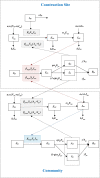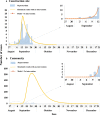Dengue fever transmission between a construction site and its surrounding communities in China
- PMID: 33407778
- PMCID: PMC7787407
- DOI: 10.1186/s13071-020-04463-x
Dengue fever transmission between a construction site and its surrounding communities in China
Abstract
Background: Due to an increase in mosquito habitats and the lack facilities to carry out basic mosquito control, construction sites in China are more likely to experience secondary dengue fever infection after importation of an initial infection, which may then increase the number of infections in the neighboring communities and the chance of community transmission. The aim of this study was to investigate how to effectively reduce the transmission of dengue fever at construction sites and the neighboring communities.
Methods: The Susceptible-Exposed-Infectious/Asymptomatic-Recovered (SEIAR) model of human and SEI model of mosquitoes were developed to estimate the transmission of dengue virus between humans and mosquitoes within the construction site and within a neighboring community, as well between each of these. With the calibrated model, we further estimated the effectiveness of different intervention scenarios targeting at reducing the transmissibility at different locations (i.e. construction sites and community) with the total attack rate (TAR) and the duration of the outbreak (DO).
Results: A total of 102 construction site-related and 131 community-related cases of dengue fever were reported in our area of study. Without intervention, the number of cases related to the construction site and the community rose to 156 (TAR: 31.25%) and 10,796 (TAR: 21.59%), respectively. When the transmission route from mosquitoes to humans in the community was cut off, the number of community cases decreased to a minimum of 33 compared with other simulated scenarios (TAR: 0.068%, DO: 60 days). If the transmission route from infectious mosquitoes in the community and that from the construction site to susceptible people on the site were cut off at the same time, the number of cases on the construction site dropped to a minimum of 74 (TAR: 14.88%, DO: 66 days).
Conclusions: To control the outbreak of dengue fever effectively on both the construction site and in the community, interventions needed to be made both within the community and from the community to the construction site. If interventions only took place within the construction site, the number of cases on the construction site would not be reduced. Also, interventions implemented only within the construction site or between the construction site and the community would not lead to a reduction in the number of cases in the community.
Keywords: Community; Construction site; Dengue; Mathematical model; Outbreak.
Conflict of interest statement
The authors declare that they have no competing interests.
Figures





Similar articles
-
Incidence dynamics and investigation of key interventions in a dengue outbreak in Ningbo City, China.PLoS Negl Trop Dis. 2019 Aug 15;13(8):e0007659. doi: 10.1371/journal.pntd.0007659. eCollection 2019 Aug. PLoS Negl Trop Dis. 2019. PMID: 31415559 Free PMC article.
-
Analysis of a Dengue Model with Vertical Transmission and Application to the 2014 Dengue Outbreak in Guangdong Province, China.Bull Math Biol. 2018 Oct;80(10):2633-2651. doi: 10.1007/s11538-018-0480-9. Epub 2018 Aug 6. Bull Math Biol. 2018. PMID: 30083966
-
Evaluating the effects of control interventions and estimating the inapparent infections for dengue outbreak in Hangzhou, China.PLoS One. 2019 Aug 8;14(8):e0220391. doi: 10.1371/journal.pone.0220391. eCollection 2019. PLoS One. 2019. PMID: 31393899 Free PMC article. Clinical Trial.
-
Administration of Defective Virus Inhibits Dengue Transmission into Mosquitoes.Viruses. 2020 May 18;12(5):558. doi: 10.3390/v12050558. Viruses. 2020. PMID: 32443524 Free PMC article.
-
Effectiveness and economic assessment of routine larviciding for prevention of chikungunya and dengue in temperate urban settings in Europe.PLoS Negl Trop Dis. 2017 Sep 11;11(9):e0005918. doi: 10.1371/journal.pntd.0005918. eCollection 2017 Sep. PLoS Negl Trop Dis. 2017. PMID: 28892499 Free PMC article.
Cited by
-
Epidemiological Characteristics and the Dynamic Transmission Model of Dengue Fever in Zhanjiang City, Guangdong Province in 2018.Trop Med Infect Dis. 2022 Aug 25;7(9):209. doi: 10.3390/tropicalmed7090209. Trop Med Infect Dis. 2022. PMID: 36136620 Free PMC article.
-
Decreased dengue transmission in migrant worker populations in Singapore attributable to SARS-CoV-2 quarantine measures.J Travel Med. 2021 Feb 23;28(2):taaa228. doi: 10.1093/jtm/taaa228. J Travel Med. 2021. PMID: 33274384 Free PMC article.
-
Model-based risk assessment of dengue fever transmission in Xiamen City, China.Front Public Health. 2023 Feb 13;11:1079877. doi: 10.3389/fpubh.2023.1079877. eCollection 2023. Front Public Health. 2023. PMID: 36860401 Free PMC article.
-
Meteorological factors and tick density affect the dynamics of SFTS in jiangsu province, China.PLoS Negl Trop Dis. 2022 May 9;16(5):e0010432. doi: 10.1371/journal.pntd.0010432. eCollection 2022 May. PLoS Negl Trop Dis. 2022. PMID: 35533208 Free PMC article.
-
Modelling the Emerging COVID-19 Epidemic and Estimating Intervention Effectiveness - Taiwan, China, 2021.China CDC Wkly. 2021 Aug 20;3(34):716-719. doi: 10.46234/ccdcw2021.177. China CDC Wkly. 2021. PMID: 34594975 Free PMC article.
References
MeSH terms
LinkOut - more resources
Full Text Sources
Other Literature Sources
Medical

